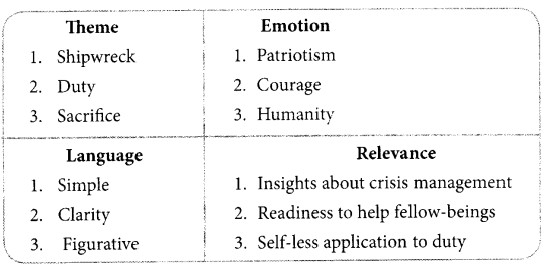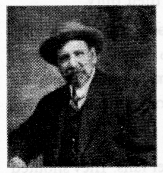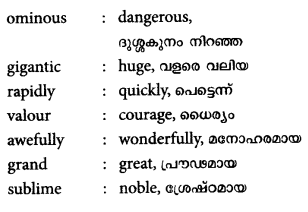Kerala Plus One English Textbook The Wreck of the Titanic Questions and Answers Unit 4 Chapter 3 (Poem)
Activity -1 (Read and respond)
Question 1.
Why was the Titanic called ‘a poem of iron and steel’?
Answer:
The Titanic called ‘a poem of iron and steel’ because it was grand and beautiful like a poem.
Question 2.
What was the feeling of the people on board when they started the journey?
Answer:
The people on board felt that they were very safe and they would not meet any danger.
Question 3.
What was the ‘ominous form ’ that loomed out of the darkness?
Answer:
The ‘ominous form’ that loomed out of the darkness was the huge iceberg that would collide with the Titanic and break it up.
Question 4.
Why was Captain Smith, the commander of the ship called, ‘brave’?
Answer:
Captain Smith, the commander of the ship was called, ‘brave’ because for not even for one moment he thought of saving his life when he knew the ship was sinking. He stood on the bridge and told his crew that they were British and they should remember their country and should do their duty. They should save the passengers first.
Question 5.
Who got the top priority to be rescued from the sinking Titanic?
Answer:
Women and children got the top priority to be rescued from the sinking Titanic.
Question 6.
What was the only hope for the people of the sinking Titanic when the all boats sailed away?
Answer: When the all boats sailed away the only hope for the people of the sinking Titanic was ‘eternity’-the hope that they will go to heaven.
Question 7.
What were the bandsmen doing when the Titanic was sinking?
Answer:
When the Titanic was sinking, he bandsmen were playing the hymn ‘Nearer my God to Thee’. It shows how courageous they were even in the face of danger.
Question 8.
What was the ‘awfully grand’ scene, according to the poet?
Answer:
According to the poet the ‘awfully grand’ scene was the courage displayed by those who were left out in the sinking ship. One of them could have saved his life but he offered his place to his friend and willingly accepted death. Definitely that was ‘awfully grand’.
Question 9.
Why would the story of the Titanic be remembered always?
Answer:
The story of the Titanic would be remembered always because of two reasons. First, it was the greatest maritime tragedy ever occurred in world history. Second, the sacrifice one sailor made by sending another person in his place, accepting death voluntarily, will be remembered always. There is no sacrifice greater than giving up one’s life one’s friend.
Activity – II:
Question 10.
Have you heard/read about any such persons? Share your answers with your friends. The crew of the Titanic were real heroes because even in the face of death, they were duty-bound, upholding certain values and principles. Do you know any such person who has upheld moral values and principles, even in the moment of death?
Answer:
I have read about one such person. He is Sydney Carton in the novel ‘A Tale of Two Cities’ by Charles Dickens. In the end we see Sydney Carton willingly dying in place of Charles Darnay, who was the husband of Lucie Manette. Sydney Carton had loved Lucie before she married Charles. Charles was to be guillotined. Sydney, who had some resemblance to Charles, saves him from the prison and dies on his behalf.
Activity – III (Appreciation)
Question 11.
Read the poem more critically again, and think of it in terms of it theme, emotion, language and relevance. Add more points to each of the boxes given related to the theme, emotion, language and relevance of the poem.

Answer:
Theme: 1. Shipwreck, 2. Duty, 3. Sacrifice
Emotion: 1. Patriotism. 2. Love for one’s fellow-beings, 3. Pity
Language: 1. Simple, 2. Lucid (clear), 3. Conversational
Relevance: 1. Insights about crisis management,
2. The need for compassion,
3. Fortitude and heroism in times of crises.
Share your ideas with your friends in your group. Collect more views from them and enrich your understanding of the poem.
Based on your analysis, write a critical appreciation of the poem, ‘The Wreck of the Titanic’.
The poem The Wreck of Titanic’ by Benjamin Peck Keith is an excellent one. The poem tells how noble people could be even in times of danger. It talks about the sinking of the Titanic and brings out the best in men even in the most adverse circumstances threatening their lives.
From Southampton the Titanic starts her voyage. It was a beautiful and grand ship. She was a sea dream. Thousands of people standing on the shore watched her steaming away. She was the largest and the grandest of all the ships made until then. There were thousands of passengers in the ship. They felt very secure. Nobody thought of any danger, as the captain stood at the wheel. He was directing the course of the ship. The ship was speeding on her first voyage when suddenly, out of the darkness, in the night, a ghostly white, iceberg appeared. Soon it collided with the ship wrecking it. It soon began to sink and people knew it was sinking.
Captain Smith was the commander of the ship. He was brave. Not even for one moment he thought of saving his life. He stood on the bridge and told his crew that they were British and they should remember their country and shocfld do their duty. They decided to send the women and children in the lifeboats. The crew had no hope of saving themselves. The Titanic sank from sight, as the band played ‘Nearer my God to Thee’. There never was a scene grander or more tragic than this. The ship was sinking but the band was playing. All credit goes to Smith, the crew and the men of Titanic. Their bravery and courage will be remembered forever. They had showed such courage and nobility during the great tragedy.
The poem has different themes which include shipwreck, duty and sacrifice. It appeals to our emotions like patriotism, love for one’s fellow-beings and pity. The poet has used simple, lucid and conversational language. The poem is in rhyme and the rhyming scheme is aabb. It has a fine rhythm and it sounds melodious. It has fine imagery and the poet has used a number of figures of speeches, especially metaphor and personification. The poem has great relevance as it gives insights about crisis management, the need for compassion, fortitude and heroism in times of crises.
Activity – IV: (Newspaper report)
Question 12.
We know that newspaper reports are non- fictional. They give us factual information about an incident.
Study the features of a good newspaper report as given on below.
- Headline : Short and attention-grabbing.
- Byline : Usually written below the headline. It may carry the writer’s name.
- Paragraphs : Follow the inverted pyramid principle. The most important details come in the initial paragraphs.
- Quotes : It will be interesting and useful to quote the words of people involved in the incident.
- Facts and opinions : Try to add all the facts possible using the five W’s (who, what, why, where, when).
- Third Person : The report is written in the third person, as the reporter is retelling the incident without being involved in it.
Work in groups and Till up the table given below:
| Features | Details |
| Headline | |
| Byline | |
| Paragraphs | |
| (Number and broad outline of each paragraph) | |
| Who | |
| What | |
| Why | |
| Where | |
| When | |
| Quotations (Narration and opinions of the survivors) |
Answer:
Features – Details
Headline – The Titanic Sinks – 1500 passenger feared dead
Byline Paragraphs Broad outline of Each paragraph – Report by Rahul Binoy five
a. Start of the voyage, number of passengers, a description of the ship.
b. How happy and confident the people were
c. The iceberg hitting the ship and wrecking it; it begins to sink.
d. The heroic captain and the crew deciding to evacuate passengers, the band playing and the crew and male passengers going down.
e. The lesson to be learnt. Nobility and heroism of people.
Survivor’s opinion – “I have never seen anything more tragic and nobler in all my life.”
Question 13.
Use the clues in the table and prepare a newspaper report about the wreck of the Titanic.
Answer:
The Titanic Sinks, More Than 1500 People Dead
Southampton: 15 April 1912: The Titanic which began its maiden voyage from Southampton to New York collided with a huge iceberg and sank in the icy waters off Newfoundland. It was the biggest passenger ship ever made and it was supposed to be unsinkable. There were 2220 passengers and nearly 60 crew members. The captain was Mr. Smith. Since the ship was thought to be safe, it earned only a few lifeboats.
Captain Smith and the crew behaved gallantly. Instead rushing to safety, they allowed the passengers to go into the. lifeboats. They asked the women and children to enter the life boats first. More than 1500 people could not get to safety and they sank with the Titanic. What Captain Smith, the crew and the male passengers did was a heroic act. It will be remembered by the posterity. England has declared a day of mourning for the dead. The government has announced some financial relief to the relatives of the victims.
One survivor- Marianne Monroe – remarked: “”l have never seen anything more tragic and nobler in all my life.”
Activity – V (Pronunciation)
Find out how the following words are pronounced:
Sank = /saet]k/
Band = /baend/
Grand = /graend/
Question 14.
Which is the vowel sound used in these words?
Answer:
/ae/
Question 15.
How do you pronounce this sound?
Answer:
As the ‘a’ in man /maen/.
Question 16.
Do you have this vowel sound in your mother-tongue?
Answer:
No, we don’t.
Question 17.
Find out more words from the poem with this vowel sound:
Answer:
The words are: and, gigantic, as, captain, that, act, than.
The Wreck Of The Titanic About the Author:

– Benjamin Peck Keith
Benjamin Peck Keith (18561927): He was an American poet. The Wreck of the Titanic’ is one of his most famous poems.
The Wreck Of The Titanic Summary
Stanza 1:
From Southampton, the Titanic started her voyage. She was a poem of iron and steel. She was a sea dream. Thousands of people standing on the shore watched her steaming away. She was the largest and the grandest of all the ships made until then.
Stanza 2:
There were thousands on board. They felt very secure. Nobody thought of any danger, as the captain stood at the wheel. He was directing the course of the ship. This would be her (the ship’s) first and the last trip as she will never reach a port again.
Stanza 3:
She was the best shipman had made. She was speeding on her first voyage when suddenly, out of the darkness, in the night, a ghostly white form appeared.
Stanza 4:
It was a huge mountain of ice. Such a huge iceberg was never seen ^n the North Atlantic. It hit the ship, sending a shiver throughout the entire length of the ship. It soon began to sink and people knew it was sinking.
Stanza 5:
Captain Smith was the commander of the ship. He was brave. Not even for one moment, he thought of saving his life. He stood on the bridge and told his crew that they were British and they should remember their country and should do their duty.
Stanza 6:
England, Ireland, Scotland and Wales proved to the world that their courage never fails. They said that the women and children should go in the lifeboats. All the crew stood by and watched.
Stanza 7:
The lifeboats were lowered and the women and children were sent away to safety. The crew had no hope of saving themselves. The Titanic sank from sight, as the band played ‘Nearer my God to Thee’.
Stanza 8: Was there ever a scene gander than this? The ship was sinking but the band was playing. Al credit goes to Smith and the men of Titanic. Once again they bring to memory the heroes of Trafalgar. (There the Royal Navy of England fought against the combined fleets of the French and Spanish Navies.)
Stanza 9:
It also brings to memory the thrilling story of the Alamo (The Texians defeated the Mexican Army, ending the revolution). It also brings to memory the battle of Waterloo (where Napoleon was defeated). It also reminds us of the charge of. The Light Brigade’ (the English forces fighting against the Russians in 1854) and also Jim Bludso’s courageous act (He was an engineer who died while saving the lives of the passengers on a boat named Prairie Bell sinking in the Mississippi river).
Stanza 10:
Along with all these stories of bravery and courage, the story of the crew of Titanic will be remembered forever. They had showed such courage and nobility during that great tragedy.
The Wreck Of The Titanic Glossary


